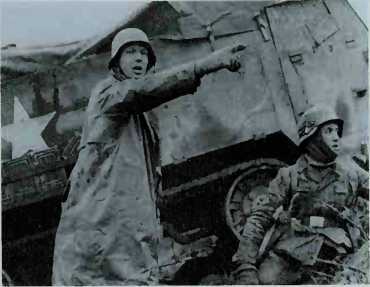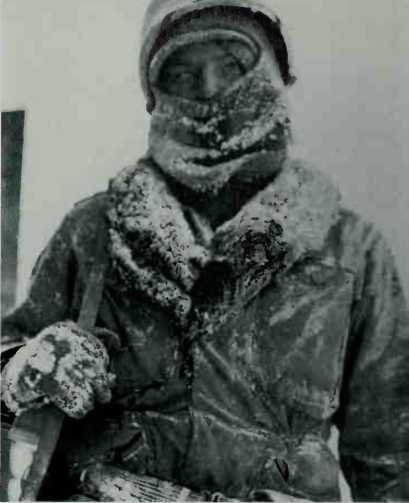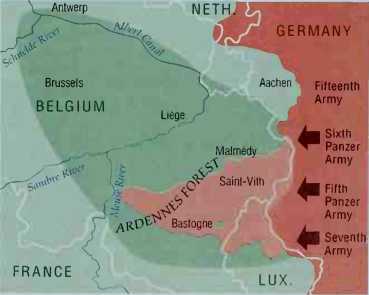Bulge During the second half of 1944,
The Allied armies had chased the Germans across the European countryside, routing them from France and Belgium. Pushed hastily from their bases in Western Europe, the Germans had no time to turn and fight.
Closing In. Now, as the year closed, the Allies brought their troops up along almost the whole length of the German fi'ontier. But as the Allies closed in on the Rhine and Germany, a desperate Hitler conceived one final surprise: a German counterattack through the Ardennes forest. The move would set American troops and their commanders reeling.
Hitler’s grand idea was to divide the Allied armies threatening his border and punch through them to Antwei-p, Belgium (see map on page 137). The Belgian city was a major supply port for the Allies. By taking it. Hitler reckoned he could cut off Allied resources and prevent them from continuing their move into Germany.
The Allied armies had been able to push their way across Europe because they controlled the air. Hitler knew his offensive had little chance unless he could

A German soldier signals his unit to advance daring the Ardennes battle. Behind him is a wrecked U. S. half-track.
Somehow keep Allied planes out of the skies. To do that, he decided to launch his offensive during bad weather.
Three Fists. Hitler needed power and speed to drive a wedge into the Allied lines. He combined four SS Panzer (armored) divisions into one powerful Sixth Panzer Army. This German fist would push out from the northern Ardennes aiming toward Antwerp. At the same time, another new Panzer Army, the Fifth, would attack in the center of the Allied lines. The German Seventh Army would also move forward in the south (see map).The combined German forces included thirty divisions and what was left of the Luftwaffe, about 1,000 planes.
Hitler kept the plans for the offensive a deep secret. When his staff eventually did find out, they believed the plan was too ambitious. But the fuhrer believed this was Germany’s last chance.
Allied intelligence, which had brought the Americans and British so far, now abandoned them. The Germans’ extreme secrecy, radio silence, and heavy cloud cover all helped to fog Hitler’s deadly threat. Nearly all of the commanders believed the Germans were incapable of launching such an offensive.
— General Anthony McAidiffe’s one-word reply to German demands that he surrender at Bastogne
Dawn Attack. The Germans began their big move early in the morning on December 16. German infantry used searchlights reflected from overhead clouds to guide them through the winter darkness. The American lines were weakly manned by green or exhausted divisions. Many were quickly surprised and overrun.
German airborne troops, speaking English and dressed in GI uniforms, were dropped in before the German advance. Their presence behind the American lines added to the GIs intense confusion and fright.
Having achieved a complete surprise, German armored units quickly blew through the Allied lines. They had gone sixty miles before Allied infantry units were able to stop them. As Hitler hoped, foul weather kept Allied bombers on the ground. The German-American slugfest was fought almost entirely on the ground. U. S. soldiers, having struggled across Europe to Germany’s border, were now being beaten back with the heavy ax of Hitler’s Panzers.
Battle of the Bulge. Everything that the Allies had accomplished since the Normandy invasion was in jeopardy. New information from ULTRA now alerted Eisenhower to the Germans’ plan to push for the Meuse River (see map). From there Hitler’s armies would be in striking distance of Antwerp.
The Americans were managing to stop the German thrust along the northern section of their lines. The worst winter in years, though, was making the defense more than difficult. Even surrender wasn’t an option. German SS units had already murdered large numbers of American prisoners.
Along the southern line, the situation was even worse. The Germans had pushed a deep salient, or bulge, into the Ardennes. The Americans had two footholds within the area. One was a line around Saint Vith reinforced by the 82nd Airborne Division. The other was the small town of Bastogne, where the 101st Airborne was holed up with some tank units. Bastogne was now surrounded, but the American defenders refused to give up.
Bastogne was a key road junction, and the Germans needed it for their push toward Antwerp. But the gritty defenders would not budge. Their resistance sucked in thousands of German soldiers. In whole or in part, nine German divisions would lay siege to Bastogne.
Patton Keeps His Promise. On December 19, General
George S. Patton had sworn he would relieve Bastogne in forty-eight hours. No one believed he could do it. Nevertheless, Patton pushed his weary Third Army northward 100 miles. Within days, Patton’s troops had broken through the German ring around Bastogne.
The German Panzer troops, the pride of Hitler’s army, had no wish to give up their choke hold on Bastogne. They lashed back in a fury against the Third Army again and again. But Patton was nothing if not stubborn. He had marched all this way in the bitter cold. He would give up nothing.
No Mercy. Eisenhower knew that the Americans had to hold the line against the Germans here. Everything was at stake; everything could be lost. The American troops, some of whom had never fought at all, were ordered to stand firm on the bitterly contested ground.
Frozen, exhausted, scared to death and beyond, U. S. troops were allowed no mercy in the Ardennes fight. The wounded and shell-shocked, if they could stand and walk, were sent back to the lines. Some were too sick to fight and froze to death in the snow. Casualties exceeded 80,000.
The relief of Bastogne was successful, though it took two more weeks to squeeze out the German bulge. In the meantime, the sky cleared and Allied planes were able to help push the Germans back. The Ardennes fight was the longest and most difficult one the American troops had seen or would see in Europe.
In the end the Battle of the Bulge was won, but at a price too terrible for any to ever forget the cost.

Hitler’s last great thrust pushed American troops to the brink—and sometimes beyond it.

As German forces pushed toward the port of Antwerp, U. S. airborne troops at Bastogne refused to snirender. Patton's Third Armv evenlnallv relieved them.




 World History
World History









